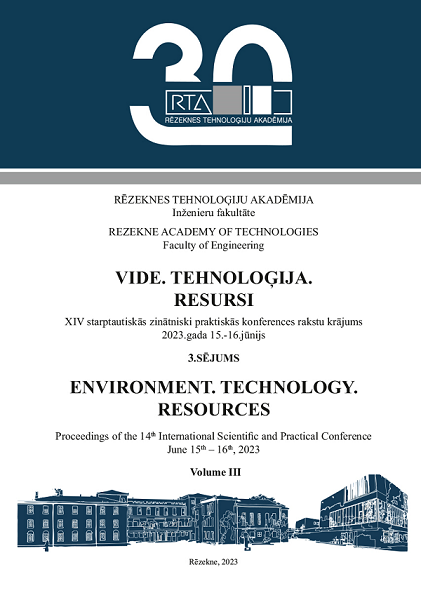RESEARCH INTO 3D PRINTING LAYER ADHESION IN ABS MATERIALS
DOI:
https://doi.org/10.17770/etr2023vol3.7255Keywords:
Adhesion between, DOE, FDM 3D printAbstract
The purpose of this article is to determine the impact of the two factors – layer thickness and printing speed in the adhesion of the layers in the ABS polymer. ABS control test tubes were printed and the tensile strength of each tube was measured. By means of statistical analysis, it was determined the impact of the layer thickness and the print speed on the adhesion between the layers. The research was focused on one of the most used materials in 3D printing. It can be concluded from the obtained results that the layer thickness has the greatest impact on the adhesion.
References
A. Mushtaq, A. Israr, M. Fahad, J. Ahmed,“ Mechanical analysis of additively manufactured polylactic acid in fused deposition modelling“, Bulgarian Chemical Communications, Volume 52, Issue 1 (pp. 29-46) 2020 https://doi.org/10.34049/bcc.52.1.4942
M. Derise, A. Zulkharnain, “Effect of Infill Pattern and Density on Tensile Properties of 3D Printed Polylactic acid Parts via Fused Deposition Modeling (FDM)”, International Journal of Mechanical & Mechatronics Engineering. 20. 54-62., 2022
A. Shafaat, H. Rezaei, “Effect of Layer Thickness and Infill Percentage on The Mechanical Characterization of Fused Deposition Modeling ABS specimens” The 5th International and 16th National Conference on Manufacturing Engineering ICME2019, 18-19 Dec 2019
S. Chowdhry, “Improving Strength of 3D Print Using RSM”, International Journal of Engineering and Applied Sciences (IJEAS). 9. 6-8. 2022
FlashFofge , FlashForge Creator 3, March 2023. [Online]. Available:
https://www.flashforge.com/product-detail/flashforge-creator-3-pro-3d-printer [Accessed: March 18, 2023].
FlashFofge , FlashPrint 5, March 2023. [Online]. Available:
https://www.flashforge.com/product-detail/FlashPrint-slicer-for-flashforge-fdm-3d-printers [Accessed: March 18, 2023].
AutoDesk , Inventor Pro 2023, March 2023. [Online]. Available:
https://www.autodesk.com/products/inventor/overview?term=1-YEAR&tab=subscription [Accessed: March 18, 2023].
Minitab , March 2023. [Online]. Available:
https://www.minitab.com/en-us/solutions/analytics/statistical-analysis-predictive-analytics/[Accessed: March 18, 2023].
K. Özsoy , A. Erçetin and Z. A. Çevik , "Comparison of Mechanical Properties of PLA and ABS Based Structures Produced by Fused Deposition Modelling Additive Manufacturing", Avrupa Bilim ve Teknoloji Dergisi, no. 27, pp.802-809,Nov.2021, https://doi.org/10.31590/ejosat.983317
C. ALVAREZ, L. Kenny; C. LAGOS, F. Rodrigo y AIZPUN, Miguel. “Investigating the influence of infill percentage on the mechanical properties of fused deposition modelled ABS parts.” Ing. Investig. [online], vol.36, n.3 pp.110-116. 2016 ISSN0120-5609. https://doi.org/10.15446/ing.investig.v36n3.56610.
Zagorski, Mihail & Todorov, Georgi & Nikolov, Nikolay & Sofronov, Yavor & Kandeva, Mara. (2022). Investigation on wear of biopolymer parts produced by 3D printing in lubricated sliding conditions. Industrial Lubrication and Tribology. ahead-of-print. https://doi.org/10.1108/ILT-06-2021-0214



